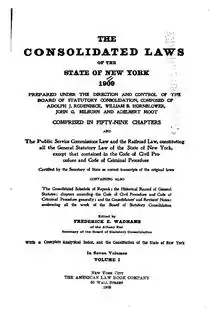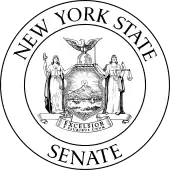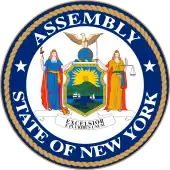New York State Legislature
The New York State Legislature consists of the two houses that act as the state legislature of the U.S. state of New York: The New York State Senate and the New York State Assembly. The New York Constitution does not designate an official term for the two houses together; it says only that the state's legislative power "shall be vested in the senate and assembly".[1] Session laws passed by the Legislature are published in the official Laws of New York.[2][3] Permanent New York laws of a general nature are codified in the Consolidated Laws of New York.[2][4] As of January 2021, the Democratic Party holds a majority in each house of the New York State Legislature, which is the highest paid state legislature in the country.
New York State Legislature | |
|---|---|
 | |
| Type | |
| Type | |
| Houses | Senate Assembly |
| History | |
| Preceded by | General Assembly of New York |
| Leadership | |
Speaker of the Assembly | |
| Structure | |
| Seats | 213 |
 | |
Political groups | Majority caucus (107)
Minority caucus
|
 | |
Political groups | Majority caucus
Minority caucus
|
| Salary | $120,000/year + per diem |
| Elections | |
Last election | November 3, 2020 |
Next election | November 8, 2022 |
| Meeting place | |
 | |
| New York State Capitol, Albany | |
| Website | |
| public www | |
Legislative houses
Legislative elections are held in November of every even-numbered year.[5] Both Assembly members and Senators serve two-year terms.[6]
In order to be a member of either house, one must be a citizen of the United States, a resident of the state of New York for at least five years, and a resident of the district for at least one year prior to election.[7]
The Assembly consists of 150 members; they are each chosen from a single-member district. The New York Constitution allows the number of Senate seats to vary; as of 2014, the Senate had 63 seats.[8] As of 2009, the New York State Legislature had 2,700 employees, more than any other state legislature except for the Pennsylvania General Assembly.[9]
Leaders
The Assembly is headed by the Speaker, while the Senate is headed by the President, a post held ex officio by the State Lieutenant Governor. The Lieutenant Governor, as President of the Senate, has only a tie-breaking "casting vote". More often, the Senate is presided over by the Temporary President,[10] or by a senator of the Majority Leader's choosing.
The Assembly Speaker and Senate Majority Leader control the assignment of committees and leadership positions, along with control of the agenda in their chambers. The two are considered powerful statewide leaders and along with the Governor of New York control most of the agenda of state business in New York.
Other officers
The Legislative Bill Drafting Commission (LBDC) aids in drafting legislation; advises as to the constitutionality, consistency or effect of proposed legislation; conducts research; and publishes and maintains the documents of the Legislature, such as the Laws of New York.[11][12] The LBDC consists of two commissioners, the Commissioner for Administration and the Commissioner for Operations, each appointed jointly by the Temporary President of the Senate and the Speaker of the Assembly.[13]
Party control
In the 2018 elections, Democrats won control of the State Senate and increased their majority in the State Assembly. At the beginning of the 2019-2020 legislative session, the Senate Democratic Conference held 39 of the chamber's 63 seats[14] and the Assembly Democratic Conference held 106 of the 150 seats in that chamber.[15] The Senate Democratic Conference increased to 40 seats after Democratic senator Simcha Felder was re-accepted into the Conference.[16]

Constitutional powers
The Legislature is empowered to make law, subject to the governor's power to veto a bill. However, the veto may be overridden by the Legislature if there is a two-thirds majority in favor of overriding in each House. Furthermore, it has the power to propose New York Constitution amendments by a majority vote, and then another majority vote following an election. If so proposed, the amendment becomes valid if agreed to by the voters at a referendum.
History
The legislature originated in the revolutionary New York Provincial Congress, assembled by rebels when the New York General Assembly would not send delegates to the Continental Congress.
The New York State Legislature has had several corruption scandals during its existence. These include the Black Horse Cavalry and Canal Ring.[17][18]
In the 1840s, New York launched the first great wave of civil procedure reform in the United States by enacting the Field Code. The Code inspired similar reforms in 23 other states, and gave birth to the term "code pleading" for the system of civil procedure it created.
The first African-American elected to the legislature was Edward A. Johnson, a Republican, in 1917.[19] The first women elected to the legislature were Republican Ida Sammis and Democrat Mary Lilly, both in 1919.[20] The first African-American woman elected to the legislature was Bessie A. Buchanan in 1955.[21]
Five assemblymen were expelled in 1920 for belonging to the Socialist Party.[22]
Legislative leadership
New York State Senate
- Temporary President of the Senate: Andrea Stewart-Cousins
- Majority Leader: Andrea Stewart-Cousins
- Minority Leader: Robert Ortt
New York State Assembly
- Speaker of the Assembly: Carl Heastie
- Majority Leader of the Assembly: Crystal Peoples-Stokes
- Minority Leader of the Assembly: Will Barclay
See also
- George G. Barnard
- Gibbons v. Ogden
- The Frawley committee and William Sulzer
- The Hepburn Committee
- List of New York Legislature members expelled or censured
- New York Provincial Congress
- New York State Assembly
- New York State public benefit corporations
- New York State Senate
References
- https://www.dos.ny.gov/info/constitution.htm New York State Constitution
- Gibson, Ellen M.; Manz, William H. (2004). Gibson's New York Legal Research Guide (PDF) (3rd ed.). Wm. S. Hein Publishing. p. 30. ISBN 1-57588-728-2. LCCN 2004042477. OCLC 54455036.
- Gibson & Manz 2004, pp. 47–48.
- Gibson & Manz 2004, pp. 56–57.
- Warren, Olivia A. "A House Divided in Washington Heights". Gotham Gazette.
- "Everything You Need to Know About New York's Primary Election on Thursday". Vogue.
- https://www.dos.ny.gov/info/constitution.htm New York State Constitution, Article III, Section VII
- McKinley, Jesse (24 February 2014). "What Is a Majority Vote in the State Senate? The Answer Goes Beyond Simple Math". The New York Times.
- Gershman, Jacob (25 November 2009). "NY's bloated Legislature". New York Post.
- "Branches of Government in New York State". NY State Senate. 2009-03-25. Retrieved 2020-02-29.
- Legislative Law § 25
- Kallos, Ben (9 June 2014). "Set the Law Free, Say Council Members Lander, Vacca, Kallos: Legislation to Put Law Online for Free Instead of Behind Paid Subscriptions" (Press release). Retrieved 12 June 2014.
- Legislative Law § 24
- "History made: Andrea Stewart-Cousins sworn in as NY Senate leader". lohud.com.
- Klepper, David; Carola, Chris (January 9, 2019). "Democrat-controlled NY state Legislature starts 2019 session". AP NEWS.
- "Felder Joins Senate Dem Fold". www.nystateofpolitics.com. Retrieved 2019-10-22.
- Archdeacon, Thomas J. (1978). "The Erie Canal Ring, Samuel J. Tilden, and the Democratic Party". New York History. 59 (4): 408–429. ISSN 0146-437X. JSTOR 23170015.
- Giroux, Gary (2013-07-12). Business Scandals, Corruption, and Reform: An Encyclopedia [2 volumes]: An Encyclopedia. ABC-CLIO. p. 255. ISBN 978-1-4408-0068-9.
- "Edward A. Johnson (Edward Austin), 1860-1944". docsouth.unc.edu.
- "Early Women Elected to the NYS Legislature". Archived from the original on January 28, 2010.
- Jessie Carney Smith, ed. (1996). Notable Black American Women. 2. Detroit Michigan: Gale Research Inc. pp. 73–75. ISBN 0-8103-9177-5. Retrieved 8 March 2010.
- Confessore, Nicholas (2009-10-21). "When the Assembly Expelled Socialists for Disloyalty". New York Times (blog).
Further reading
- "Compiling the Legislative History of a New York State Law". New York State Library. Retrieved 20 June 2014.
External links
- Official site of the New York Senate
- Official site of the New York Assembly
- Legislative information from the Legislative Bill Drafting Commission
- Legislative Retrieval System (subscription required) from the Legislative Bill Drafting Commission
- The New York State Legislature Portrait Prints Collection at the New York Historical Society

